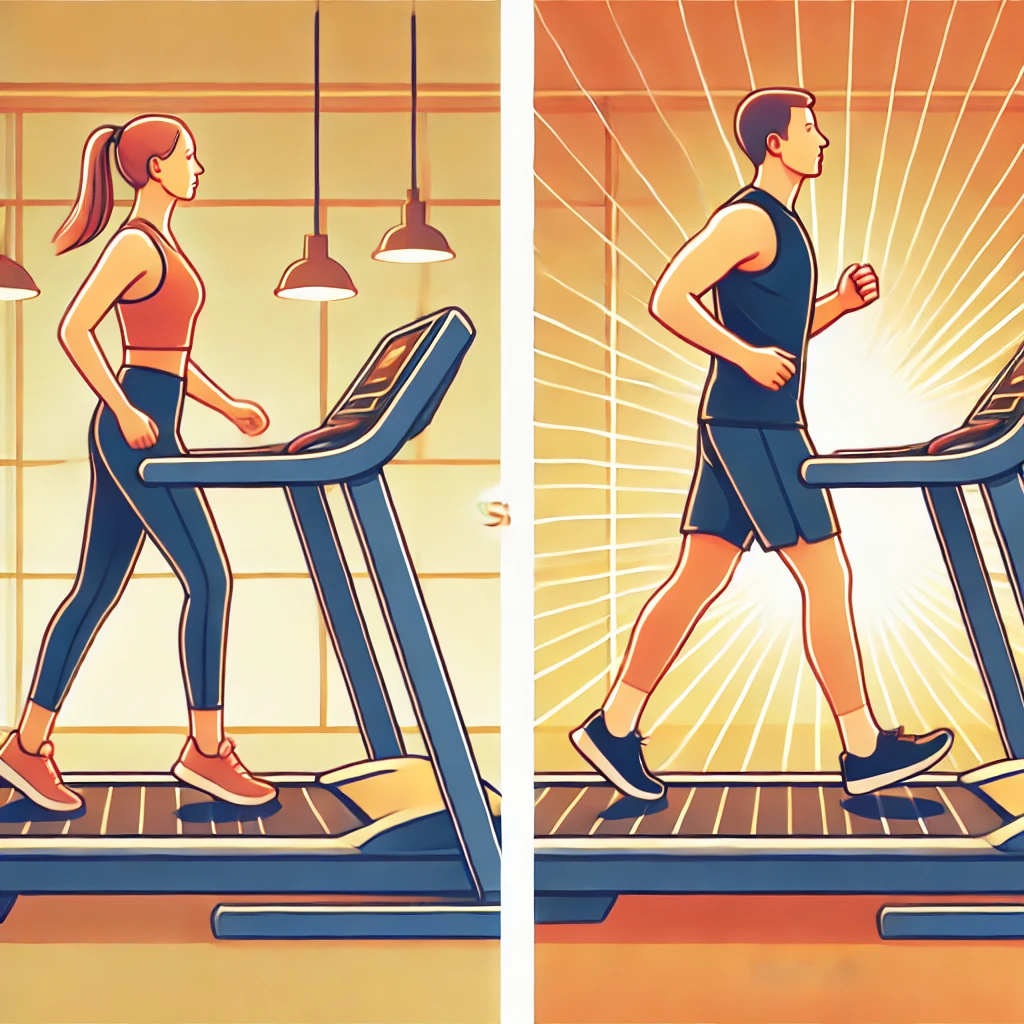When it comes to cardio workouts, incline walking and flat jogging each offer unique benefits. Both exercises improve cardiovascular health, burn calories, and build endurance, but they differ in muscle engagement, impact on joints, and how they align with specific fitness goals. Here’s a comprehensive comparison to help you decide which activity might be the best fit for you.
Calorie Burn and Cardiovascular Fitness
For those looking to maximize calorie burn, jogging on a flat surface has an edge over incline walking due to its higher intensity.
- Calorie Burn in Jogging: A 155-pound person running at a moderate pace of 6 mph (about 10 km/h) can burn around 300-400 calories in 30 minutes. This intense activity elevates the heart rate quickly, making it an efficient option for calorie burn.
- Calorie Burn in Incline Walking: Walking at a moderate pace (around 3.5 mph) with an incline of 5%–10% can burn roughly 200-300 calories for the same person in 30 minutes. While it’s lower than flat jogging in terms of intensity, the incline provides resistance that can sustain a significant calorie burn over a longer period.
Both exercises boost cardiovascular health by strengthening the heart and improving circulation. However, flat jogging may lead to faster gains in cardiovascular fitness due to its intensity, making it a great choice for those with weight loss or endurance goals.
Muscle Engagement and Strength
Incline walking and jogging engage different muscle groups, each with unique benefits:
- Incline Walking: Walking on an incline activates muscles in the lower body, specifically the glutes, hamstrings, calves, and quadriceps. The uphill movement requires extra effort from these muscles, leading to greater muscle tone, strength, and endurance. Incline walking can even engage the core muscles for stability, making it an excellent choice for those looking to build lower body strength and enhance core stability.
- Flat Jogging: Jogging works a wider range of muscles, including the hip flexors, quads, hamstrings, calves, and glutes. While it engages these muscles through repetitive motion, the resistance is lower than incline walking, making it less targeted for muscle growth in the lower body.
Impact on Joints
The impact on joints is a significant factor when choosing between incline walking and jogging.
- Incline Walking: As a low-impact exercise, incline walking minimizes the stress on joints, particularly the knees and hips, making it a safer option for individuals with joint sensitivities, injuries, or those looking to avoid high-impact activities. The slower, controlled movement reduces the risk of repetitive stress injuries.
- Flat Jogging: Jogging is a high-impact exercise, which means it puts more stress on the joints with each step. Although this impact can promote bone density, it may also increase the risk of joint strain, particularly for those who are new to exercise, have existing joint issues, or are carrying extra weight.
Fat Loss and Weight Management
When it comes to long-term fat loss and weight management, both incline walking and flat jogging have advantages, but for different reasons:
- Sustained Incline Walking: Due to its lower intensity, incline walking can be sustained for longer periods. This prolonged duration can lead to a substantial calorie expenditure over time, making it ideal for weight management without the strain of high-impact exercises. It’s a great choice for individuals who want to incorporate daily, low-impact activity that still supports calorie burn.
- Intense Jogging Intervals: Jogging can deliver quick calorie burn in a shorter time frame, making it efficient for fat loss when time is limited. However, the intensity means it might be harder to sustain for long durations compared to incline walking. Alternating between jogging and incline walking can provide a balanced routine that supports both fat loss and endurance.
Choosing the Right Exercise for You
The choice between incline walking and flat jogging depends on your fitness goals, physical condition, and preferences.
- For Joint-Friendly Cardio: Incline walking is ideal for low-impact, sustained exercise, making it perfect for individuals with joint sensitivities, beginners, or anyone looking to incorporate a gentler form of cardio.
- For High-Intensity Workouts: Flat jogging is beneficial for those who want a faster calorie burn and enhanced cardiovascular fitness and have no issues with high-impact movements.
- For a Balanced Routine: Combining incline walking with intervals of jogging can offer the best of both worlds—muscle engagement, calorie burn, and cardiovascular improvement without overloading the joints.
Final Thoughts
Incline walking and flat jogging each have their place in a well-rounded fitness routine. Whether you prefer the high-calorie burn of jogging or the joint-friendly benefits of incline walking, both exercises can support weight management, cardiovascular health, and muscular strength. By selecting the activity that best aligns with your goals and physical needs, you’ll be set to reap the benefits of an effective, enjoyable workout routine.
Share this content:



